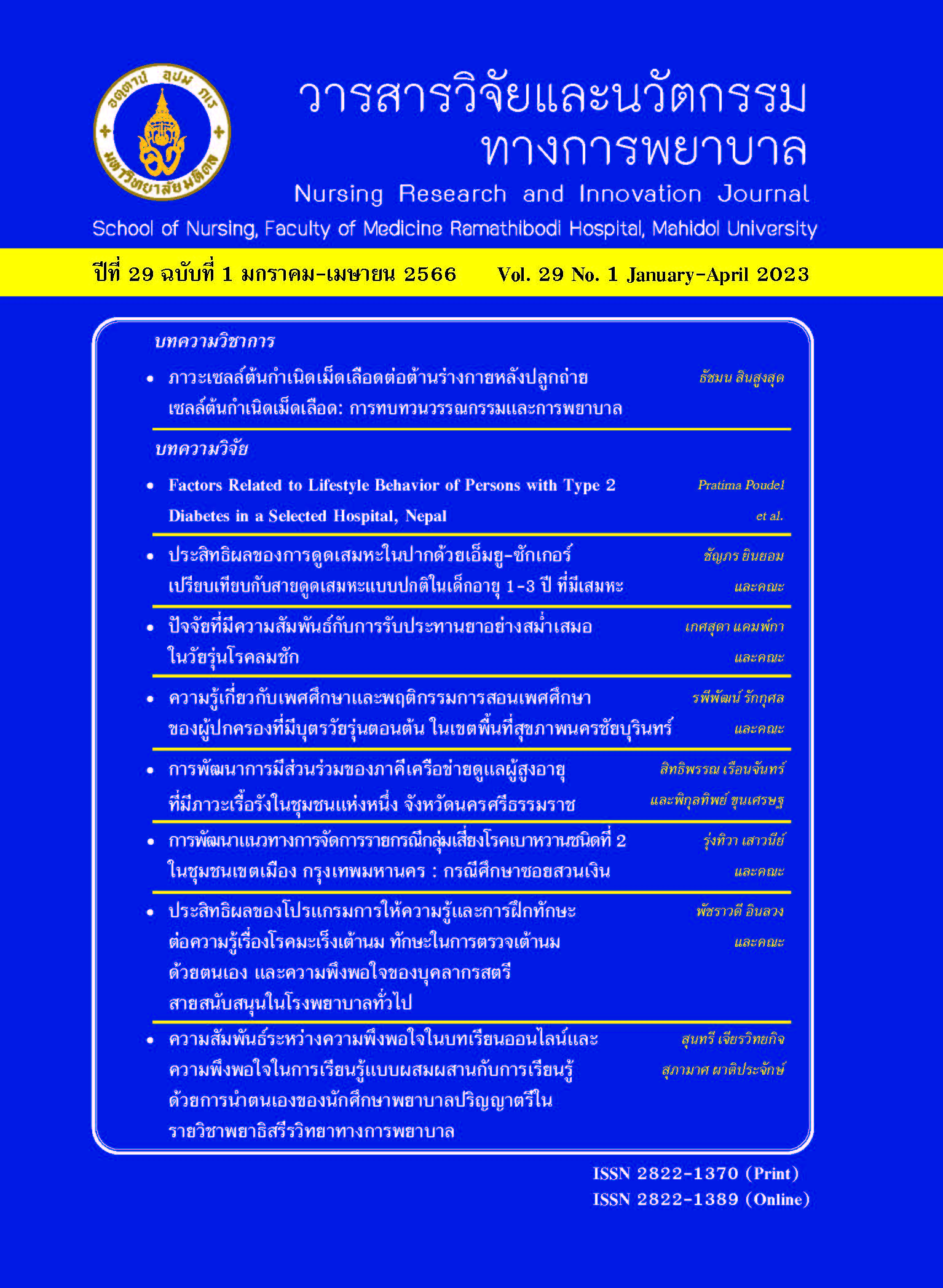The Effectiveness of Oropharyngeal Suction Using MU-Sucker Compared with the Conventional Suction Catheter in 1-3 Year-Old Children with Secretion
Main Article Content
Abstract
Secretion is an important problem in children with respiratory infections. Effective suction is considered a necessary treatment. In young children who cannot remove all secretions by themselves, oropharyngeal suctioning is essential to remove them from the airway. This study used a randomized crossover design to investigate the effectiveness of oropharyngeal suction using the MU-Sucker compared with the conventional suction catheter in 1–3 years-old children with secretion. The differences between the use of MU-Sucker and conventional suction catheter were compared in three main areas: pain during suctioning, secretion volumes, and the injury of respiratory mucosa. The sample consisted of 30 children aged 1-3 years who needed suctioning.The patients who met the inclusion criteria were purposively recruited. The method used for suctioning was randomly selected between the MU-Sucker and conventional suction catheter.When one method was used for the first time, another method was followed by the same group of
patients. Both methods of suctioning were performed at least three hours apart. The means in pain scores and secretion volumes were compared between two methods using the non-parametric Wilcoxon signed-rank test, and the injury of respiratory mucosa was compared with the chi-square test. The findings showed that the mean pain score for oropharyngeal suction using MU-Sucker was not significantly less than the conventional suction catheter. The mean secretion volume using MU-Sucker was not significantly greater than the conventional suction catheter. Likewise, the injury of respiratory mucosa using MU-Sucker was not significantly less than the conventional suction. The results revealed that even if oropharyngeal suction with the MU-Sucker might not be more effective than the conventional suction catheter, from the interviews with nurses and caregivers, they were satisfied with using MU-Sucker. Their reasons were that the length of MUSucker was convenient to hold, and this procedure needed only one person to do suctioning. It could be said that the MU-Sucker is a product that could be used as an option for oropharyngeal suctioning, and its effectiveness is the same as the conventional one.
Keywords: Injury of respiratory mucosa, MU-Sucker, Oropharyngeal suction, Pain, Secretion volumes
Article Details

This work is licensed under a Creative Commons Attribution-NonCommercial-NoDerivatives 4.0 International License.
บทความ ข้อมูล เนื้อหา รูปภาพ ฯลฯ ที่ได้รับการตีพิมพ์ในรามาธิบดีพยาบาลสาร ถือเป็นลิขสิทธิ์ของวารสาร หากบุคคลหรือหน่วยงานใดต้องการนำทั้งหมดหรือส่วนหนึ่งส่วนใดไปเผยแพร่หรือเพื่อกระทำการใด ใด จะต้องได้รับอนุญาตเป็นลายลักษณ์อักษรจากรามาธิบดีพยาบาลสารก่อนเท่านั้น
References
Khumwong Y, Amornputthisathaporn N, Utrarachkij J.Bronchial hygiene therapy. In: Kiatboonsri S,Veerangkabutra T, Theerawit P, Kuptanon T, editors.Principle and practical points in respiratory care. Bangkok:Beyond Enterprise; 2015. p.45-65. (in Thai)
Asanasen P. Anatomy and physiology of nose and paranasal air sinuses; 2008 [cited 2017 November 26]. Available from: https://www.studocu.com/row/document/dalianmedical-university/anatomy/anatomy-and-physiologyof-nose-and-paranasal-air-sinus/5160222 (in Thai)
Pongsasanaongkul J. Chest physiotherapy. In: Phuttiphan A, Chaisupamongkollarp T,Utrarachkij J, KamalapornH,Kuptanon T,editors. The essentials of pediatric respiratory care: Bangkok: Beyond Enterprise; 2007. p.185-94. (inThai)
Rangsan R. Pediatric intubation and ventilation management; 2016 [cited 2018 January 11]. Available from: https://ergoldbook.blogspot.com/2016/07/pediatric-intubation-and-ventilation.html (in Thai)
Khowsawanon S. Nursing care of pediatric patients with respiratory problems. In: Musiksukun S, Tiloksakulchai F, Lertthamthewi W, Prueangwet A, Saengphoem P,Phayakkharueang S, editors. Pediatric nursing textbook 2.5thed. Bangkok: Sahamitr Printing and Publishing; 2018.p.619-21. (in Thai)
Srisingha K. Physiology of the respiratory system. In:Srijantongsiri S, Srisingha K, editors. Respiratory tract infection in children. 1st ed. Phitsanulok: Naresuan University Publishing House; 2021. p.30-49. (in Thai)
World Health Organization. Pneumonia; 2021 [cited2022 January 8] Available from: https://www.who.int/news-room/fact sheets/detail/pneumonia.
Niyomwit K, Khammarit S. Nursing care to reduce sputum retention in pediatric patients. Journal of Phrapokklao Nursing College. 2019;30(1):218-23. (in Thai)
Pongsasanaongkul J. Chest physiotherapy. In: Phuttiphan A, Chaisupamongkollarp T, Utrarachkij J, Kamalaporn H, Kuptanon T, editors. Pediatric & respiratory critical care. Bangkok: Beyond Enterprise; 2007. p.185-94. (inThai)
Premprawat S. Endotracheal suctioning in patient with tracheal intubation. Journal of Nursing Science.2008;26(1):14-24. (in Thai)
Association of Pediatric Chartered Physiotherapists.Guideline for nasopharyngeal suction of a child or young adult; 2015 [cited 2017 November 26]. Available from:https://apcp.csp.org.uk/system/files/guidelines_for_nasopharyngeal_suction_0_1.pdf
Utrarachkij J. MU-Sucker; 2016 [cited 2017 November 26] Available from: https://www.thailandtech show.com/view_techno.php?id=686 (in Thai)
Institute for Technology and Innovation Management Mahidol University. MU-Sucker; 2020 [cited 2020 December 12] Available from: https://www.rama.mahidol.ac.th/mpu-ec/innovations/28jan2020-1001(in Thai)
Chang AB. Cough, cough receptors, and asthma in children. Pediatr Pulmonol. 1999;28:59-70.
Phansak W. Suctioning. In: Chatchaisucha S, Ujaratana P, Boonchan N, editors. Basic skills in nursing. Bangkok:N P Press Part.; 2007. p.215-26. (in Thai)
Chinkhanaphan Ch, Jantaramanee V, SaeTew P,Phormpayak D. Nurses ’s challenge in reducing suffering from suctioning in patient with tracheal intubation. Journal of Sakon Nakhon Hospital. 2019;22(2):66-77. (in Thai)
Sonthimuang S. The efficacy oropharyngeal and nasopharyngeal suctioning by using MU-TIP on premature infants receiving nasal continuous positive airway pressure ventilatory support. Ramathibodi Nursing Journal 2011;17(2):203-17. (in Thai)
Faul F, Erdfelder E, Lang AG, Buchner A. G*Power 3:a flexible statistical power analysis program for the social,behavioral, and biomedical sciences. Behav Res Methods.2007;39(2):175-91.
Merkel SI, Voepel-Lewis T, Shayevitz JR, Malviya S.The FLACC: a behavioral scale for scoring postoperative pain in young children. Pediatr Nurs. 1997;23(3),293-7.
Suraseranivongse S. Validation of pain measurements in Thai children aged 1-5 years within 24 hours following operation [thesis]. Bangkok: Chulalongkorn University;1999.
Jintanadilok N. Important concepts in pediatric nursing.In: Musiksukun S, Tiloksakulchai F, Lertthamthewi W,Prueangwet A, Saengphoem P, Phayakkharueang S,editors. Pediatric nursing textbook 1. 5th ed. Nonthaburi,Sahamitr Printing and Publishing; 2018. p.238-47. (in Thai)
Singhapol A. The effects of using MU Sucker with traumatic and caregiver’s satisfaction in young childpatients. Journal of the Department of Medical Services.2020;46(1):237-42. (in Thai)


